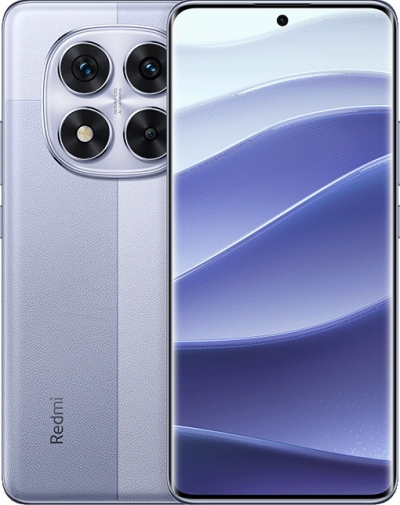In March 2025, the Redmi Note 14 Pro 5G was released in Japan. In the open market (SIM-free) segment, the previous model was the Redmi Note 13 Pro+ 5G, which was released in 2024. This time, we will compare these two devices.
Compare the body designs of Redmi Note 14 Pro 5G vs Redmi Note 13 Pro+ 5G side by side.

Redmi Note 14 Pro 5G

Redmi Note 13 Pro+ 5G
Let's start by placing the two devices side by side. Both feature a dual-tone design, aiming for an iconic and fresh look. Rather than focusing on a premium feel, they prioritize a friendly and approachable design, which is characteristic of mid-range models. The overall design concept remains largely unchanged.
Since camera functionality continues to be a key focus in 2025, the Redmi Note 14 Pro 5G follows the design trend of placing a large camera unit in the center.
On the other hand, the Redmi Note 13 Pro+ 5G adopts what is called a "deco-less design," positioning the camera unit in the upper left corner for a more minimalist look. As a result, it maintains a more traditional smartphone appearance.
Design preferences will vary from person to person. One key difference is the back panel material: the Redmi Note 14 Pro 5G features a leather-like resin panel, while the Redmi Note 13 Pro+ 5G has a matte glass back. While material preference is subjective, the Redmi Note 14 Pro 5G offers advantages such as better grip, ease of handling, and lighter weight. However, in terms of visual appeal, the Redmi Note 13 Pro+ 5G may have the upper hand.
Compare the Redmi Note 14 Pro 5G vs Redmi Note 13 Pro+ 5G Body and Display at Actual Size
Let's compare the front sides of both devices at actual size.
As you can see, the Redmi Note 14 Pro 5G is slightly larger than the Redmi Note 13 Pro+ 5G by about 1mm. However, both still feature a 6.67-inch display, so the screen size remains unchanged. The slight increase in the Redmi Note 14 Pro 5G’s overall size can be attributed to its larger battery capacity.
Despite the slight size increase, the difference is only about 1mm. More importantly, the Redmi Note 14 Pro 5G is approximately 15 grams lighter, making it somewhat easier to carry compared to its predecessor.
While both models have the same resolution and refresh rate, the maximum brightness has significantly improved. The Redmi Note 13 Pro+ 5G had a peak brightness of 1,800 nits, whereas the Redmi Note 14 Pro 5G reaches 3,000 nits, making it considerably brighter.
-
Redmi Note 14 Pro 5GMTT MOMOCO78% 8:07AnTuTu ver10
 Redmi Note 14 Pro 5G
Redmi Note 14 Pro 5G









-
Redmi Note 13 Pro+ 5GMTT MOMOCO78% 8:07AnTuTu ver10
 Redmi Note 13 Pro+ 5G
Redmi Note 13 Pro+ 5G









Compare Redmi Note 14 Pro 5G vs Redmi Note 13 Pro+ 5G in a Specifications Chart
The camera specs haven't changed significantly. The main camera of the Redmi Note 13 Pro+ 5G highlighted its 200MP resolution as a key selling point, and this has been carried over to the Redmi Note 14 Pro 5G. Both models support 4x lossless zoom by utilizing the 200MP sensor. However, the Redmi Note 14 Pro 5G features an end-to-end (E2E) AI remosaic algorithm, which greatly improves processing speed and image quality, making it more promising in terms of photo output. Additionally, the front camera has been upgraded to 20MP with an f/2.2 aperture.
One notable aspect is the processor. While the Redmi Note 13 Pro+ 5G is powered by MediaTek's Dimensity 7200-Ultra, the Redmi Note 14 Pro 5G uses the Dimensity 7300-Ultra. Despite the higher model number, benchmark tests indicate that the processing speed remains the same or sometimes even lower, meaning there's little practical difference in performance.
The battery capacity has slightly increased from 5,000mAh in the Redmi Note 13 Pro+ 5G to 5,110mAh in the Redmi Note 14 Pro 5G. However, video playback time has significantly decreased from 19 hours on the Redmi Note 13 Pro+ 5G to just 15 hours on the Redmi Note 14 Pro 5G. This is likely due to the upgraded display and processor differences.
Both models have IP68 water and dust resistance. One key difference to note is that while the Redmi Note 13 Pro+ 5G supports eSIM and FeliCa, the Redmi Note 14 Pro 5G does not.
| Redmi Note 14 Pro 5G | Redmi Note 13 Pro+ 5G | |

|

|
|
| Manufacturer | Xiaomi | Xiaomi |
| Release Date | ||
| Screen Size | 6.67 inch | 6.67 inch |
| Resolution | 1,220 x 2,712 | 1,220 x 2,712 |
| Display Details | CrystalRes AMOLED | AMOLED |
| Max Refresh Rate | 120 Hz | 120 Hz |
| Max Brightness | 3000 nits | 1800 nits |
| Body Size | 74.42mm x 162.33mm x 8.4mm | 74.2mm x 161.4mm x 8.9mm |
| Weight | 190 g | 204.5 g |
| Processor | MediaTek Dimensity 7300-Ultra | MediaTek Dimensity 7200-Ultra Octa-core processor, up to 2.8GHz |
| OS | Android 14 | Android 14 |
| Main camera 1 | 200-megapixel(f/1.65) | 200-megapixel(f/1.65) |
| Main camera 1 details | 1/1.4”, OIS | 1/1.4”, OIS |
| Main camera 2 | 8-megapixel(f/2.2) | 8-megapixel(f/2.2) |
| Main camera 2 details | ultra-wide | Ultra Wide Angle |
| Main camera 3 | 2-megapixel(f/2.4) | 2-megapixel(f/2.4) |
| Main camera 3 details | macro | Macro |
| Main camera 4 | ||
| Main camera 4 details | ||
| Main camera 5 | ||
| Main camera 5 details | ||
| Sub camera 1 | 20-megapixel(f/2.2) | 16-megapixel(f/2.4) |
| Sub camera 1 details | ||
| Sub camera 2 | ||
| Sub camera 2 details | ||
| Battery | 5,110 mAh | 5,000 mAh |
| Video playback time | 15 hours | 19 hours |
| RAM(GB) | 8/12 G | 8/12 G |
| ROM(GB) | 256/512 G | 256/512 G |
| Antutu | 652,000 ver10 | 745,000 ver10 |
| Water resistance | IPX8 | IPX8 |
| Dust resistance | IP6X | IP6X |
| SIM | nanoSIM+nanoSIM | dual SIM(nano SIM + eSIM) |
| NFC | NFC-enabled | Felica |
In the end, which is better, Redmi Note 14 Pro 5G vs Redmi Note 13 Pro+ 5G?
Generally, newer models in the same series tend to improve upon most features of their predecessors. However, when comparing the Redmi Note 14 Pro 5G with the Redmi Note 13 Pro+ 5G, it becomes evident that the older model outperforms the newer one in several aspects.
The global Redmi Note 14 series consists of five models, with the Redmi Note 14 Pro+ 5G positioned above the Redmi Note 14 Pro 5G. However, as of March 2025, the Pro+ variant was not released in Japan's open market. This leads to a comparison between the lower-tier 14 Pro 5G and the highest-tier 13 Pro+ 5G, creating an unusual contrast. On the other hand, the au-exclusive 13 Pro 5G exists, and when comparing it with the 14 Pro 5G, the generational improvements appear more natural.
That aside, the Redmi Note 13 Pro+ 5G stands out in several areas, including support for FeliCa (Osaifu-Keitai), eSIM compatibility, processing speed, and longer video playback time. Additionally, as a previous-generation model, price reductions can be expected, making it a more practical choice.
Meanwhile, the Redmi Note 14 Pro 5G offers advantages in terms of display brightness, improved AI-powered image processing for photography, and slightly reduced weight.
If you want to experience the latest AI-enhanced camera features and a better display, the Redmi Note 14 Pro 5G is the right choice.
However, if you’re drawn to the 200MP 4x lossless zoom but also want eSIM support, FeliCa, better processing speed, and a lower price, the Redmi Note 13 Pro+ 5G remains an attractive option even after the launch of the Redmi Note 14 Pro 5G.
Let's Compare Redmi Note 14 Pro 5G vs Redmi Note 13 Pro+ 5G in More Detail
We recommend comparing the Redmi Note 14 Pro 5G vs Redmi Note 13 Pro+ 5G in more detail through the following link and making an informed purchase decision.
Compare the screen of Redmi Note 14 Pro 5G vs Redmi Note 13 Pro+ 5G with animation.
Compare the Antutu scores of Redmi Note 14 Pro 5G vs Redmi Note 13 Pro+ 5G in a graph.
Compare the weight of Redmi Note 14 Pro 5G vs Redmi Note 13 Pro+ 5G in a graph.
Compare the thickness and slimness of Redmi Note 14 Pro 5G vs Redmi Note 13 Pro+ 5G in a graph.





















